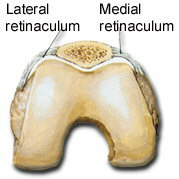Patella
The patella is your kneecap. It is a small bone that sits in front of your knee joint. It actually is embedded in the quadriceps tendon. It slides in a groove called the trochlea on the femur as the knee moves. The patella has a thick cartilage lining but is also subject to high stresses.
Chondromalacia Patella
This is a Latin term meaning “bad cartilage” or breakdown or softening of cartilage. It is one of the most common problems of the knee. Running and jumping can aggravate this condition.
Symptoms include pain in the front of the knee and a crunching or grinding sound with motion. Swelling can occur at times. Symptoms seem to be worse with climbing up or down stairs or a hill. Also, getting up from prolonged sitting can cause pain.
The cartilage surface on the underside of the patella becomes soft. Part of the cartilage can become stringy and flake off at times. Part of the surface may become roughened. The synovium in the knee which is a normal substance that helps lubricate the knee joint can sometimes be aggravated in this condition and contribute to the grinding feeling.
Treatment
Initial treatment for chondromalacia patella emphasize strengthening activities. Often a therapist is used to teach a patient quadriceps exercises to help the patella become rebalanced in a sense. Anti-inflammatory medication can be used temporarily as well as ice. Occasionally, a therapist may teach an athlete taping techniques that are helpful. In cases not responsive to conservative treatment, arthroscopy may be helpful.
Patella Maltracking
The normal patella should track in the groove of the femur in a relatively straight manner. There are varying degrees of malalignment and tracking. In some cases the patella may tend to track more to the side of the knee or actually be tilted as it goes back and forth in its groove. On occasion it may actually come partially out of the groove, which is called subluxation. Some patients have a positive “J-sign” in which, in full extension, the patella tilts and is pulled strongly to the side of the leg.
The tracking of the patella can be influenced by different things. Most of it is influenced by the anatomical shape of the knee. The following can all contribute to the maltracking of the patella: shallowness of the femoral groove, the angle of the knees (knock-knees), rotation of the hips, foot positioning on the floor (pronation or flat feet), weakness of the quadriceps, and the shape of the patella.
Treatment
Treatment for this emphasizes quadriceps strengthening. The middle muscle of the quadriceps, called the vastus medialis obliquus, or VMO, is the muscle that is focused on to try to balance the patella in its motion. Occasionally, taping can also help with this. If conservative measures are not helpful, surgical treatment is reasonable. Rebalancing the kneecap by opening some tissue on the outside of the knee can be done arthroscopically. Occasionally tightening the medial structures can also help. In most patients, this type of surgery would be all that they would need. In some patients with a significant problem and with patella subluxation or dislocation, a more extensive realignment procedure is sometimes used.
Patella Dislocation
When the patella is completely out of its groove it is called dislocated. Features listed above contributing to maltracking kneecaps can also attribute to a kneecap that is easier to dislocate. A common scenario is standing full weightbearing on a leg with a foot planted and twisting the opposite way from the leg and feeling a sudden tear or pop in the knee with the kneecap dislocating. Sometimes the kneecap will pop back into place by itself and sometimes a trip to a medical facility is needed. Once a kneecap has dislocated, typically the medial structures become loose and it is easier to re-dislocate. The danger of patella dislocation or recurrent dislocation is continued abnormal tracking with cartilage damage under the kneecap or cartilage being chipped off as the patella dislocates over the edge of the femur.
Treatment
Treatment for this again emphasizes strengthening but surgery is more common for this type of patella problem. Again, arthroscopic release of the tissues on the outside of the knee will sometimes help prevent further dislocating problems. On occasion, a more extensive procedure is needed. Either way, strengthening exercises are critical for treatment.



